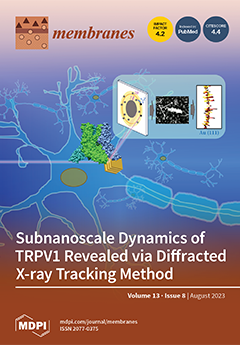Competition for the migration of interfering cations limits the scale-up and implementation of the Donnan dialysis process for the recovery of ammonia nitrogen (NH
4+-N) from wastewater in practice. Highly efficient selective permeation of NH
4+ through a cation exchange
[...] Read more.
Competition for the migration of interfering cations limits the scale-up and implementation of the Donnan dialysis process for the recovery of ammonia nitrogen (NH
4+-N) from wastewater in practice. Highly efficient selective permeation of NH
4+ through a cation exchange membrane (CEM) is expected to be modulated via tuning the surface charge and structure of CEM. In this work, a novel CEM was designed to form a graphene oxide (GO)-polyethyleneimine (PEI) cross-linked layer by introducing self-assembling layers of GO and PEI on the surface of a commercial CEM, which rationally regulates the surface charge and structure of the membrane. The resulting positively charged membrane surface exhibits stronger repulsion for divalent cations compared to monovalent cations according to Coulomb’s law, while, simultaneously, GO forms π–metal cation conjugates between metal cations (e.g., Mg
2+ and Ca
2+), thus limiting metal cation transport across the membrane. During the DD process, higher NH
4+ concentrations resulted in a longer time to reach Donnan equilibrium and higher NH
4+ flux, while increased Mg
2+ concentrations resulted in lower NH
4+ flux (from 0.414 to 0.213 mol·m
−2·h
−1). Using the synergistic effect of electrostatic interaction and non-covalent cross-linking, the designed membrane, referred to as GO-PEI (20) and prepared by a 20 min impregnation in the GO-PEI mixture, exhibited an NH
4+ transport rate of 0.429 mol·m
−2·h
−1 and a Mg
2+ transport rate of 0.003 mol·m
−2·h
−1 in single-salt solution tests and an NH
4+/Mg
2+ selectivity of 15.46, outperforming those of the unmodified and PEI membranes (1.30 and 5.74, respectively). In mixed salt solution tests, the GO-PEI (20) membrane showed a selectivity of 15.46 (~1.36, the unmodified membrane) for NH
4+/Mg
2+ and a good structural stability after 72 h of continuous operation. Therefore, this facile surface charge modulation approach provides a promising avenue for achieving efficient NH
4+-selective separation by modified CEMs.
Full article
 to open them.
to open them.





